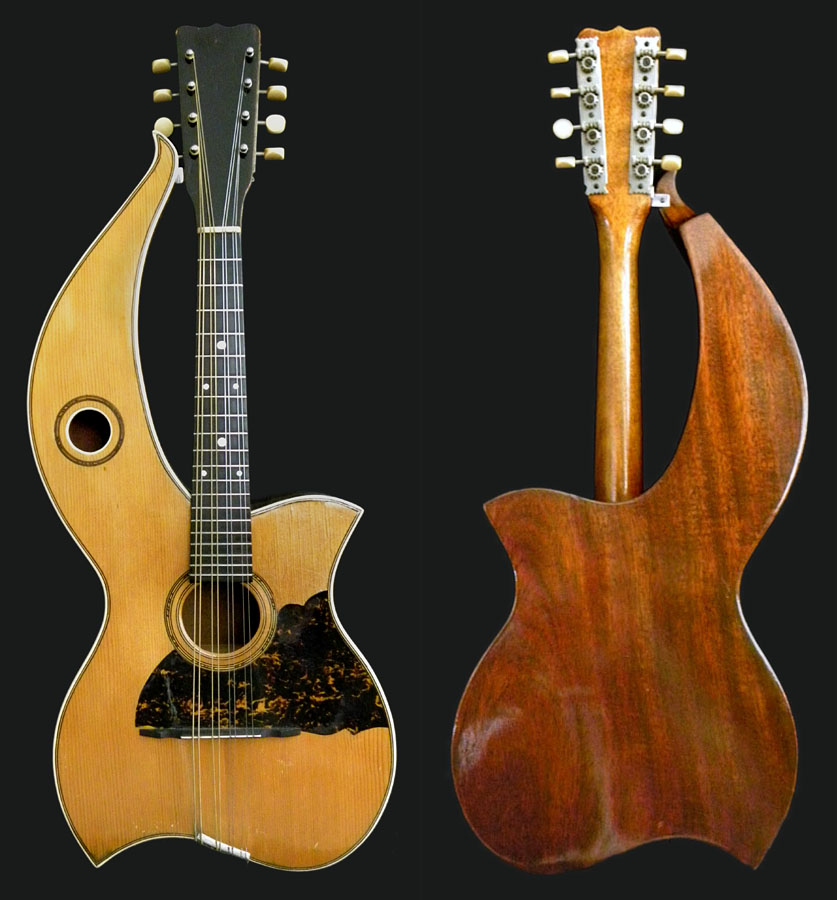
There are two dozen or more Dyer harp mandolins known to survive at this point, and other than some interesting, but subtle, differences (outside of the obvious different “Styles” of trim), most of us should be familiar with them by now.
So: What is wrong with this picture?
That’s what the owner was apparently asking when he sent the photo to me the other day. The note was very cryptic, and I didn’t know what he was asking about – Value? To sell? More info? I had glanced at the attached photo, seen a typical Dyer mando (probably a Style 20, in very nice shape), and called up the owner – Kevin Fraser – to get the skinny.
He said, “Well you say you’ve never seen one before…”
I answered (politely, I hope) “I’m not sure what you mean, we’ve seen many of these; they’re all on the site.”
Mr. Fraser responded, “No, the one in the 1908 ad that you say doesn’t exist.”
Me: (gulp) “Wait a minute!” While on the phone, I then rotated the image 90 degrees on my screen (as you see it now; his photo had it sideways). “Oh (yelp or expletive)! Now I see what you’re saying!”
Now do you see it?
It’s the body points – one’s on the “wrong” side!
A small matter of aesthetics, I suppose (I prefer this original “Knutsen-style” arrangement to the later common version, myself) – but to Dyer geeks (the entire small handful of us), a true “missing link.”
Here it is compared to the later version:
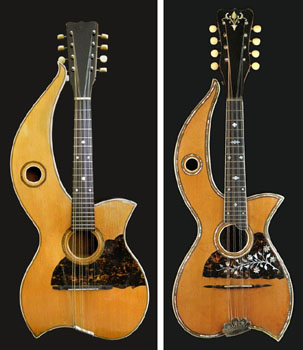
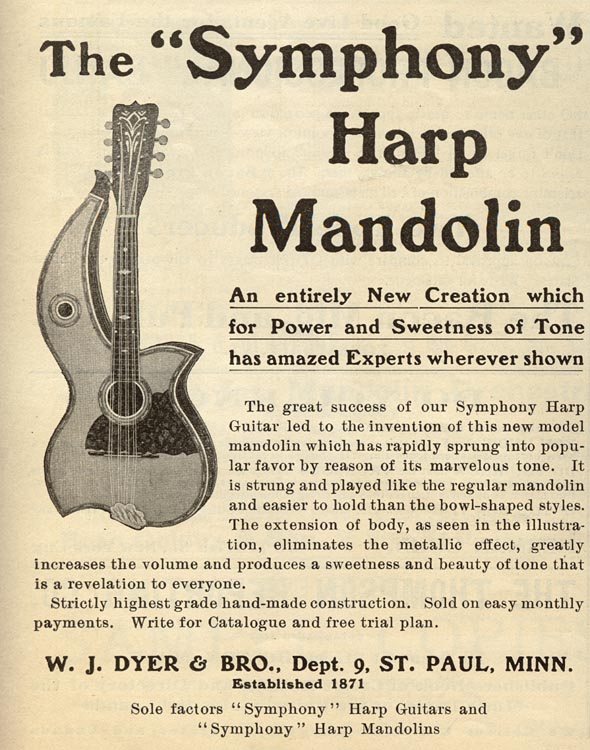
Dedicated readers will remember the details from the Dyer Harp Mandolin Family Timeline, where I show the September 1908 ad (at left) and point out its different design (while admitting that it took Bob Hartman and me years to notice the first time…!). And most importantly, that none had ever been found. Why was that?
My theory is that they had just been created (pre-September, 1908, so a woodcut could be prepared for that month’s Cadenza issue) – likely designed by the Larson brothers – but then were quickly re-vamped into the design we’re familiar with. The answer could have been a simple aesthetic change of heart, but my gut tells me it was tied up in the whole complex Knutsen-Dyer relationship (a mystery that continues to slowly unravel). Specifically, Knutsen had recently switched his harp guitar design to his “lower bass point” shape, along with the occasional “double point” specimen – which featured two flared body points that were “kitty-corner.”
I imagine a (hypothetical, mind you) gentleman’s agreement whereby Larson’s harp mandolins for Dyer were altered so that they wouldn’t look exactly like miniature Knutsen harp guitars of 1908.
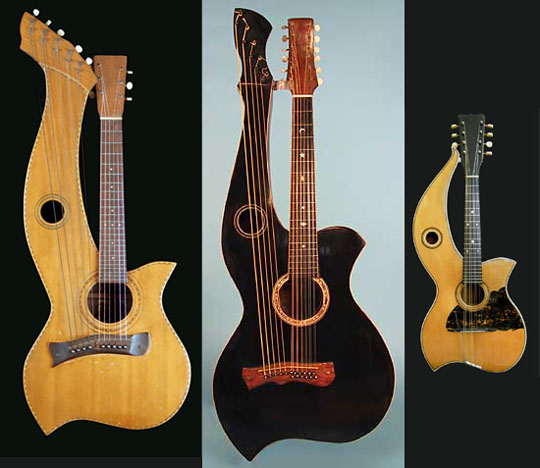
Above we see the somewhat common Knutsen ¾ scale Double Point harp guitar, a less common full-scale Knutsen Double Point (so far, always with 12 strings on the neck), and the original 1908 Dyer harp mandolin. Would it really be surprising to mistake Dyer’s new harp mandolin as a Knutsen instrument?
Alas, the all-important label information is missing from this rare specimen. In fact, it doesn’t look like it ever had a label glued in there. Another clue? Perhaps, if we imagine that this instrument was a prototype (or one of several) that was not intended for sale. Just a guess. The fact that our lowest harp mandolin serial so far found is #105 suggests that just 4 others were made before that one. But with the discovery of possible unlabelled prototypes, we of course have no way of knowing if they were included in the “count” (say up to four, then the first numbered instrument appeared with the new design) – or not counted at all (in which case there could have been any number of pre-production harp mandolins, and we would expect to see #101-104 in the common design as well).
Any other provenance? Not really. Mr. Fraser (who plans on keeping his treasure) inherited it from his grandfather, who “died young” in 1938 and was thought to have been born by 1890 – so could have perhaps bought it new, but just as easily later, secondhand. He lived in Iowa Falls.
And now we must pause for this commercial break…
Incredibly, just as I had finished this blog and was about to schedule it for the week I’m away, Mr. Fraser (who had been Googling) found a second one of these instruments! It was just listed for sale at Vintage Instruments in Philadelphia (now on its way to purchaser Bob Hartman) – and it has a label.
That’s the good news. The bad news is that I had thought that we finally now had enough serial number evidence to place all the Dyer harp mandolin forms (“phases”) into a logical sequence that fit my proposed timeline and Knutsen vs. Larsons theory. I had originally closed this article with that conclusion, all wrapped in a tidy, little package and tied with a bow (and very pleased with myself).
Now we start over – and not remotely for the first (or, probably, last) time in our hunt for Dyer history and serial number systems.
First: Here are the three early “optical illusion” specimens compared:
The two new specimens – both Style 20 (denoting trim level) – look almost exactly like the one in the woodcut, which was a fancier model. The left specimen is missing its label, the right specimen is serial no. 12x (probably 128). Note the arm tip, which on this original version is longer than it would become later. The difference between the two new specimens may be due largely to camera angle and also neck/headstock/body alignment angles. In both existing specimens, the spruce top extends all the way onto the carved tip; in the ad specimen, the spruce stops at the junction of the carved tip, the only time I think I’ve seen it do so. The body was also wider originally.
Next: To familiarize you with our lineup of “suspects,” a comparison of the three distinct forms (phases), in my originally presumed order:
In this scenario, the first version, Fraser’s unlabelled Phase 1 specimen which matches the first Sept 1908 ad, has the Knutsen double point locations. It is 9-3/16″ wide and 2-3/8″ deep. This version was theoretically then modified, by simply moving the lower bass bout point to the opposite side. These early Phase 2 instruments are 9 to 9-1/8” wide. Soon, the final “Phase 3” appeared – the slightly skinnier version most of us are familiar with, having a lower bout width of 8-5/8 to 8-3/4”. This would have been made until the end of production (by about 1920 at the latest, I believe).
Ignoring my Knutsen vs. Larson design theories above, this scenario still seems to make sense from both an evolutionary aspect and the advertising timeline. But now we introduce the serial number evidence:
In this scenario, I have switched the first two forms, using the serial numbers only as evidence. At far left is #105, the earliest Dyer harp mandolin known, yet it is not the “1908 backward” model. An identical instrument in the Chinery book #107. The unlabelled Fraser specimen is shown next in numerical, as we now have its twin with the number #12x (~128). Finally, the Phase 3 form, with the lowest confirmed serial number being #156 and all remaining Phase 3’s with higher numbers (the pictured specimen being #188).
So which were built first? The numbers so far point to this system, yet the ads do not. Or do they? Actually, yes, as there is no ad that specifically shows the fat #105/107 specimens. So perhaps they were the first, and then the body point switch occurred – into the Knutsen form – for whatever reason. Finally (between late 1908 and sometime in 1910) they switched the point back (for reasons that could still incorporate my Knutsen design theory above) and thinned the profile. Of course, one could come up with all sorts of hypothetical explanations for why Mr. Fraser’s specimen has no label, or #128’s label (an older, unsold prototype was finally sent to the Dyer store, whereby the next sequential label was then inserted…), so it may remain impossible for us to ever know for certain.
And now I have to incorporate some new theory into the site’s Dyer pages.
Do I know? Do I have a guess? I’d say yes, but I know I’ll just be re-writing the Dyer section again the second the words are out of my mouth!

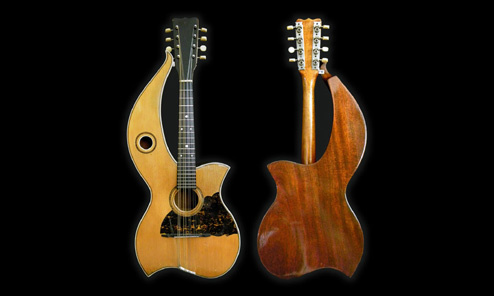
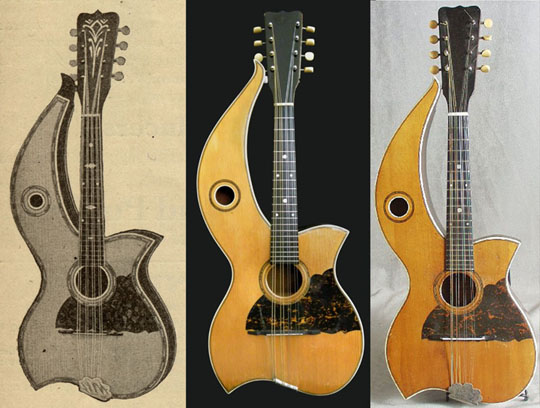
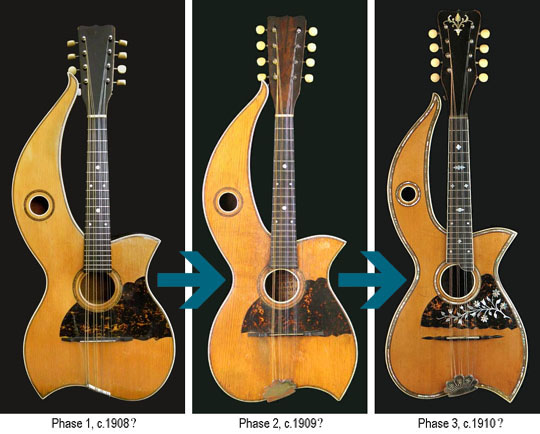

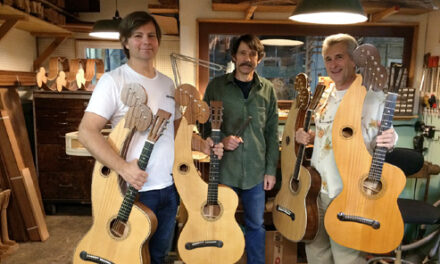
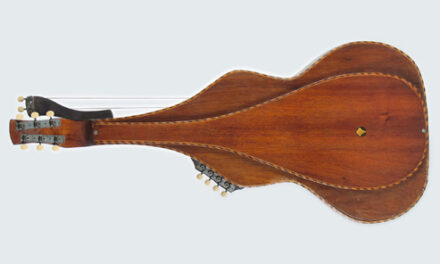
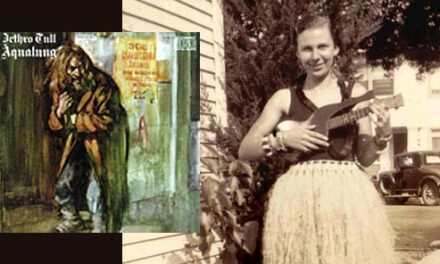
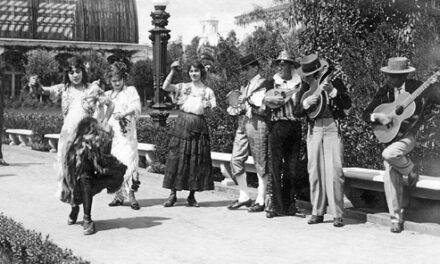
Good observation, Bob. The time frame could fit. However, why then does their September, 1908 Dyer harp mandolin match Knutsen’s double-point more-so than their own Style 3 harp guitar…?
The answer to the 1908 mandolin body point design could be as simple as making it to match the 1908 Styel 3 harp guitar which also has the bass side point. Both are extremely rare. It seems like they both were built for a very short time frame and then changed to the standard models that followed.
If we live long enough maybe a matching 1908 mandola or mando-cello will come up for air! Don’t hold your breath!
As mentioned above, Bob Hartman shrewdly snagged the new harp mando from Vintage Instruments. Here’s its label: https://www.harpguitars.net/history/dyer/dyermando12Xlabel-hartman.jpg
Unfortunately, the last number isn’t really legible, so I’ll add it to the serial number list as “12-“. But that changes nothing in the above brainstorming. Bob agrees with the idea that they must have indeed switched back and forth between forms for some reason. Here it is with his custom Larson family harp mandolin and his Style 3 harp guitar: https://www.harpguitars.net/history/dyer/dyermandocompare-hartman.jpg